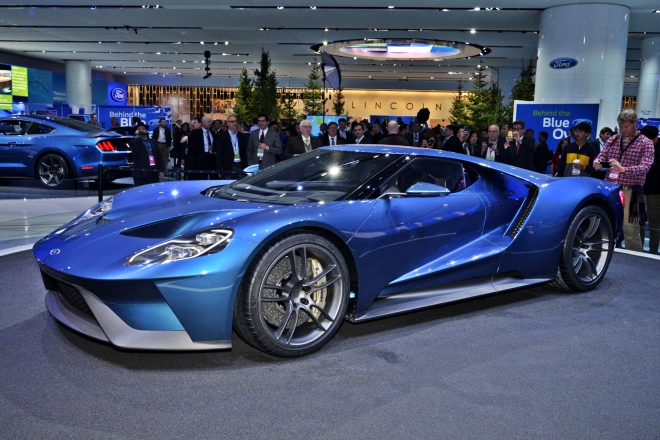
Acura takes the wraps off its highly anticipated next-generation NSX supercar, designed to deliver a groundbreaking “New Sports eXperience”
Twenty-five years after the debut of the original, paradigm-shifting NSX supercar, Acura revealed the production version of its highly anticipated successor—the next-generation Acura NSX, developed and produced in the U.S.—to the world’s auto media at the 2015 North American International Auto Show today. The production model, in a scintillating NSX Red finish, took the stage with a growl from its twin-turbocharged engine.
The next generation NSX showcases the production styling, design and specifications of Acura’s mid-engine sports hybrid supercar, and Acura announced key details of the all-new vehicle’s design and performance. The company will begin accepting custom orders for the new NSX starting in the summer, with customer deliveries expected later in the year.
Specifically created to bring a “new sports experience” to the supercar segment, the NSX challenges conventional beliefs about supercars — much as the first generation did a quarter century ago. The approach is realized through an all-new power unit—a twin-turbocharged 75-degree DOHC V6 engine with a 9-speed dual clutch transmission (DCT) and three-electric motor Sport Hybrid system—integrated with an ultra-rigid and lightweight multi-material body with world’s-first material applications and manufacturing processes. Developed under the concept of a “human-centered supercar,” a car that puts the driver first in every aspect of its design, the next-generation NSX will leverage its state-of-the-art hybrid supercar power unit, body and chassis to deliver exceptionally intuitive and immediate response to driver inputs.
“Our commitment was to create an all-new NSX that is true to the heritage of NSX—a supercar that delivers a new driving experience, one where every part of the vehicle is respectful of the smartest part of the car, the driver,” said Mike Accavitti, senior vice president and general manager of the Acura division. “The soul of a car is the emotional connection it makes with the driver. With the NSX, that connection will be intense and immediate.”
As the pinnacle representation of Acura performance and prestige, the NSX was introduced at the auto show under the theme of “Precision Crafted Performance.” The theme was the original tagline for the Acura brand, a guiding force behind the development of the original NSX and a critical component of its launch.
The development of next-generation NSX, driven by precision crafted performance, has resulted in a clean-sheet design, which involved nearly three years of intensive development effort by a global design and engineering team led by engineers at the company’s development center in Raymond, Ohio.
“The NSX reflects Acura’s American roots and makes a powerful statement about the strong role being played by our North American operations in envisioning and building the future of Acura,” said Erik Berkman, executive vice president of the Acura Business Planning Office.
“Our global team embraced the challenge to create a new sports car experience, leveraging new technology to deliver incredibly vivid performance in a vehicle that responds intuitively and immediately to the will of the driver,” said Ted Klaus, chief engineer and global development leader of the new NSX. “The NSX delivers pinnacle supercar performance, with zero-delay acceleration and exhilarating, confidence-inspiring driving dynamics.”
Interwoven Dynamic Exterior Design
“The new NSX is a product of what we term ‘Interwoven Dynamic’ design,” said Michelle Christensen, NSX exterior design project leader. “It represents the ideal blending of exotic sports car form and supercar function.”
The NSX body features classic low and wide proportions married to modern and alluring surfacing, an aggressive front design, and tail lights that pays homage to the original NSX. The signature side intake and floating C-pillar collects air to feed the mid-mounted engine and directs airflow over the rear deck to increase downforce. To accommodate the new longitudinally mounted twin-turbo V6 and 9-speed DCT, the production vehicle was lengthened (+3 inches) and widened (+1 inch) with a slightly more cab-forward package, compared with the proportions of the NSX Concept shown in 2012.
Every element of the exterior body design has been carefully fashioned for total airflow management for both stability-enhancing downforce and vehicle systems cooling. The NSX has undergone extensive testing at the company’s state-of-the-art wind tunnel in Raymond, Ohio, leading to a number of significant changes from concept to final body design, including modified hood vents, new front fender vents, modified side air intakes, and an optimized deck spoiler.
Dimensions:
| NEW NSX | 2013 NSX Concept | Diff (in.) | 2005 NSX | Diff (in.) |
| Length | 176 in.
(4470 mm) | 172.8 in. (4390mm) | +3.1 | 174.2 in.
(4425 mm) | +1.8 |
| Width | 76.4 in.
(1940 mm) | 75.4 in
(1915 mm) | +1.0 | 71.3 in.
(1810 mm) | +5.1 |
| Height | 47.8 in.
(1215 mm) | 47.2 in.
(1200 mm) | +0.6 | 46.1 in
(1170 mm) | +1.8 |
| Wheelbase | 103.5 in. (2630 mm) | 102.8 in.
(2610 mm) | +0.8 | 99.6 in.
(2350 mm) | +11.0 |
| Front track | 65.2 in.
(1655 mm) | – – | – – | 59.5 in.
(1510 mm) | +5.7 |
| Rear track | 63.6 in.
(1615 mm) | – – | – – | 60.7 in.
(1540 mm) | +3.0 |
Human Support Cockpit
“Consistent with the ‘human-centered supercar’ development concept, the NSX was designed from the inside out with an uncompromising focus on the driver,” said Johnathan Norman, NSX interior design project leader. “Like the original NSX, we created a ‘Human Support Cockpit’ that provides exceptional driver control, visibility and packaging, but further advanced to meet the extreme performance expectations of a modern supercar.”
The NSX interior boasts exceptional forward visibility, simple and intuitive controls, and class-leading ergonomics—most notably the seat, which features top-class holding performance with outstanding comfort and easy ingress/egress.
The NSX’s instrument cluster features a dynamic TFT display that responds to changes in the driver-selectable Integrated Dynamics System with pertinent graphics and information. The center console holds the Power button that readies the sport hybrid powertrain, nested in the center of the new Integrated Dynamics System dial control. Interwoven under the handcrafted leather dash panel is the exposed midframe—a functioning chassis structural member that reflects the design aesthetic of a naked sport bike. An ultra-thin, yet super strong A-pillar design and low-mounted instrument panel minimize obstructions to the driver’s view of the road.
Sport Hybrid Power Unit
In keeping with the foundational philosophy of the original NSX, the next-generation NSX is designed to provide a new sports car experience that maximizes the capabilities of the driver, delivering exceptionally intuitive and confidence-inspiring response “at the will of the driver.”
Acura engineers leveraged the company’s expertise both with high-performance engine and hybrid electric-drive technologies, as well as its two decades of experience with industry-leading dynamic torque-vectoring technologies, including Super-Handling All-Wheel Drive (SH-AWD), to create the most sophisticated, technologically advanced and intelligent powertrain in the supercar universe.
At the heart of the NSX’s performance capabilities is an all-new mid-mounted, 75-degree, DOHC V6 engine with twin turbochargers mated to an Acura-developed 9-speed DCT. The V6 engine employs a race-inspired compact valve train and dry sump lubrication system to help lower the center of gravity. The all-new 9-speed DCT delivers synapse-quick gear changes and rev-matching downshifts. The rear direct-drive electric motor, housed between the engine and transmission, supports acceleration, braking and transmission shifting performance. The NSX’s front wheels are driven by twin independent high-output electric motors which deliver instantaneous torque response and dynamic left-to-right torque distribution.
The NSX uses its front electric motors for dynamic torque vectoring in addition to enhancing acceleration and braking performance. The result is an instantaneous “zero delay” launch performance and handling response that seems to anticipate the driver’s desire. The NSX has undergone extensive testing at some of the world’s most challenging race circuits, including the famed Nurburgring.
Advanced Multi-Material Body
Also in keeping with the legacy of NSX—the world’s first all-aluminum supercar—the new NSX features an innovative new multi-material body design with world’s-first material applications and construction processes.
The NSX body utilizes a space frame design—an internal frame constructed of aluminum, ultra-high strength steel and other advanced materials. Anchored by a carbon fiber floor, torsional and bending forces are taken up entirely by this ultra-rigid structure which also utilizes advanced joining technologies.
The NSX features world’s-first casting technology that combines the design and manufacturing flexibility of a casting process with the strength and elongation properties of a forged material, enabling significant weight reduction. The body panels are composed of a combination of aluminum and sheet molding composite (SMC).
Advanced Sport Package
The NSX features an “Advanced Sports Package” with placement of key powertrain components –the mid-mounted engine, twin front motors and Sport Hybrid battery pack and power control unit – optimized to concentrate vehicle mass low and toward the center of the vehicle, to further enhance dynamic response. The combination of this packaging concept and the lightweight body give the NSX the lowest center of gravity in its class.
The NSX utilizes a fully independent, all-aluminum front and rear suspension and puts its considerable power down through ContiSportContact™ high-performance tires—245/35Z R19 front and 295/30Z R20 rear—mounted on 19×8.5 inch front and 20×11 inch rear aluminum alloy wheels. Powerful, natural and confident braking performance is provided by 6-piston front and 4-piston rear monoblock calipers squeezing ultra-high performance carbon-ceramic brake discs.
Handling is greatly enhanced by Sport Hybrid Super-Handling All Wheel Drive (Sport Hybrid SH-AWD), enabling lightning-quick response to all driver inputs—steering, braking and throttle—along with the stability, control and launch performance of all-wheel drive. Agile Handling Assist (AHA) uses the subtle application of brake torque to further enhance yaw response and dynamic stability.
The NSX’s dial-operated Integrated Dynamic System features Quiet, Sport, Sport+ and Track modes. The system adjusts engine, motor, transmission and chassis response, as well as the engine sound level, based on the needs of the driver and driving environment. Quiet mode enables electric-only driving at lower speeds for short durations. Dynamic vehicle responses become increasingly sharp as the driver moves from Sport to Sport+ mode and, finally, to Track mode, where the NSX reveals the full spectrum of its performance capabilities.
The NSX also features a “launch” function to achieve the ultimate in “zero delay” launch performance, aided by both the engine and three electric motors.
New Production Facility
The NSX will be manufactured exclusively at the Performance Manufacturing Center (PMC) in Marysville, Ohio, where approximately 100 highly-skilled associates will conduct full body construction, paint, and final assembly using domestic and globally-sourced parts.
The PMC and its processes have been developed to perfectly blend associate craftsmanship and technology in a new approach to manufacturing. By in-housing the body construction, Acura maintains complete control over total body quality, including critical strength, suspension accuracy, and fit and finish—from initial construction all the way to final assembly.
Associates will utilize innovative techniques to deliver next-generation craftsmanship and world-class quality in the realm of specialized, supercar vehicle production.










